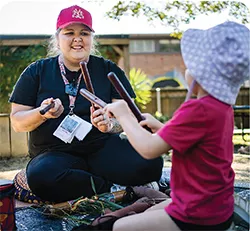Table of contents
- BELONGING, BEING & BECOMING - THE EARLY YEARS LEARNING FRAMEWORK
- (EYLF) INTRODUCTION
- (EYLF) A VISION FOR CHILDREN'S LEARNING
- (EYLF) ELEMENTS OF THE EARLY YEARS LEARNING FRAMEWORK
- (EYLF) EARLY CHILDHOOD PEDAGOGY
- (EYLF) PRINCIPLES
-
(EYLF) PRACTICES
- (EYLF) Holistic, integrated and interconnected approaches
- (EYLF) Responsiveness to children
- (EYLF) Play-based learning and intentionality
- (EYLF) Learning environments
- (EYLF) Cultural responsiveness
- (EYLF) Continuity of learning and transitions
- (EYLF) Assessment and evaluation for learning, development and wellbeing
- (EYLF) THE EARLY YEARS LEARNING FRAMEWORK PLANNING CYCLE
- (EYLF) LEARNING OUTCOMES
- (EYLF) GLOSSARY OF TERMS
- (EYLF) REFERENCES
Need help using the guide? Visit our help section.
(EYLF) Assessment

Assessment strategies are selected by educators for different purposes. Assessment strategies include observations, documentation, reflections and gathering of information about, and with, children and their families. Through assessment, educators describe and interpret children’s actions, interactions and communications to consider their achievements, capabilities and wellbeing in relation to the Learning Outcomes. Educators understand the importance of including children’s voices and contributions to assessment. Assessment strategies that are inclusive, culturally and linguistically relevant, and responsive to the physical, emotional, social, intellectual and regulatory capabilities of each child will acknowledge each child’s abilities, strengths and competencies. Through assessment, educators recognise and celebrate not only the giant leaps children take in their learning but the small steps as well.
Educators utilise 3 broad types of assessment.
- Assessment ‘for children’s learning’, also known as formative assessment, is when information about what children know, can do and understand is gathered and analysed to inform pedagogy and planning. Educators use a variety of strategies to collect rich and meaningful information that depicts children’s learning in context, describes their progress and identifies their strengths, learning dispositions, skills and understandings. Used effectively, formative assessment strategies can capture the different pathways that children take in their learning journeys and make the process of learning visible to children and their families, educators and other professionals.
- Assessment ‘of children’s learning’, also known as summative assessment, is when educators review children’s achievements and capabilities at specified or selected timepoints, such as during their transition into the early childhood setting, mid-year, or for their transition to school. Educators make professional judgements about children’s learning progress over time, to show the ‘distance travelled’ by learners. In their summative assessments, educators can critically reflect on how children have engaged with increasingly complex ideas and participated in increasingly sophisticated learning experiences. Summative assessment can also be based on children’s attainment of developmental milestones, which can be helpful if educators have a concern about a child’s learning abilities or wellbeing. Educators can use such information to start a conversation with families and for potential referral to other professionals for diagnostic assessment.
- Assessment ‘as learning’ is used to facilitate children’s awareness, contributions and appreciation of their own learning. Children’s voices and contributions to assessment can be captured using strategies such as child portfolios or ‘talking and thinking floorbooks’ to involve children in documenting learning. This allows children to reflect on their learning and develop an understanding of themselves as learners, what they like to learn, and how they learn best. When children, families and other professionals are included in the development and implementation of relevant and appropriate assessment processes, new understandings can emerge that would not be possible if educators rely solely on their own perspectives. Developing inclusive assessment practices with children and their families demonstrates respect for diversity, and helps educators, families and children make better sense of the assessment information. Assessment undertaken in collaboration with families can assist them to support children’s learning and empower families to act on behalf of their children within and beyond the early childhood setting.